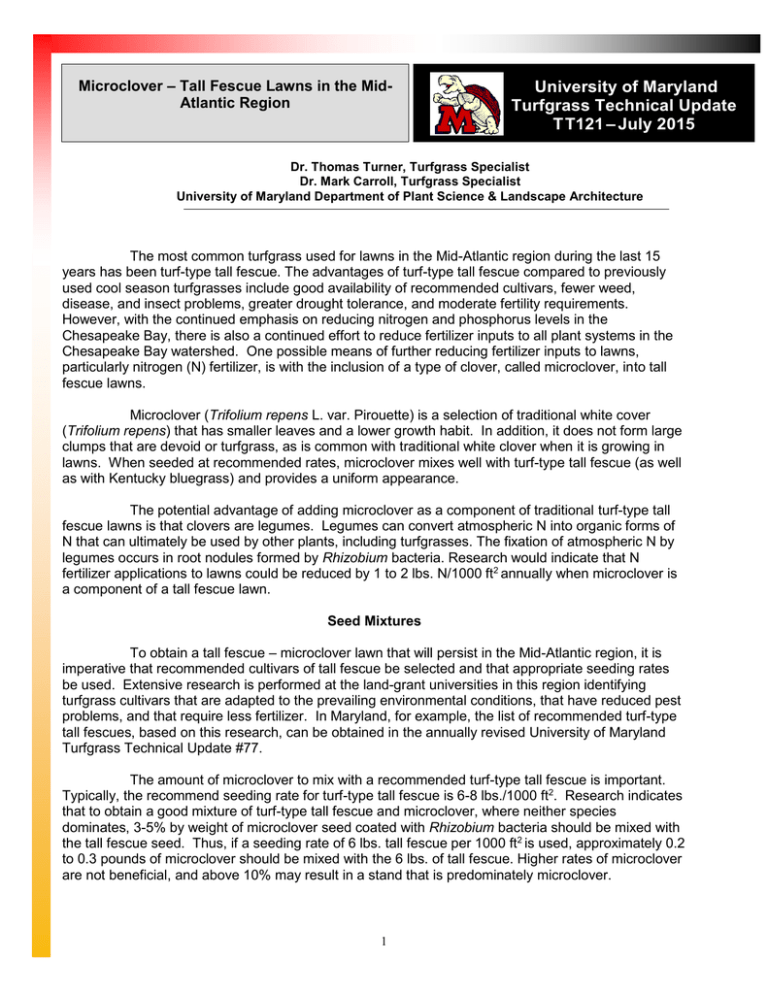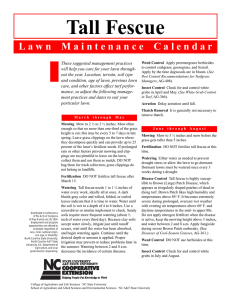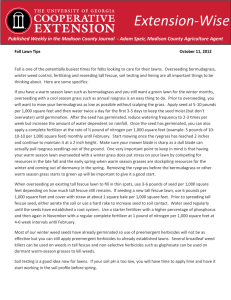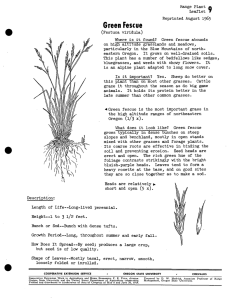– Tall Fescue Lawns in the Mid- Microclover Atlantic Region
advertisement

D Microclover – Tall Fescue Lawns in the MidAtlantic Region University of Maryland Turfgrass Technical Update T T121 – July 2015 Dr. Thomas Turner, Turfgrass Specialist TT-77 Specialist Dr. Mark Carroll, Turfgrass University of Maryland Department of Plant Science & Landscape Architecture The most common turfgrass used for lawns in the Mid-Atlantic region during the last 15 years has been turf-type tall fescue. The advantages of turf-type tall fescue compared to previously used cool season turfgrasses include good availability of recommended cultivars, fewer weed, disease, and insect problems, greater drought tolerance, and moderate fertility requirements. However, with the continued emphasis on reducing nitrogen and phosphorus levels in the Chesapeake Bay, there is also a continued effort to reduce fertilizer inputs to all plant systems in the Chesapeake Bay watershed. One possible means of further reducing fertilizer inputs to lawns, particularly nitrogen (N) fertilizer, is with the inclusion of a type of clover, called microclover, into tall fescue lawns. Microclover (Trifolium repens L. var. Pirouette) is a selection of traditional white cover (Trifolium repens) that has smaller leaves and a lower growth habit. In addition, it does not form large clumps that are devoid or turfgrass, as is common with traditional white clover when it is growing in lawns. When seeded at recommended rates, microclover mixes well with turf-type tall fescue (as well as with Kentucky bluegrass) and provides a uniform appearance. The potential advantage of adding microclover as a component of traditional turf-type tall fescue lawns is that clovers are legumes. Legumes can convert atmospheric N into organic forms of N that can ultimately be used by other plants, including turfgrasses. The fixation of atmospheric N by legumes occurs in root nodules formed by Rhizobium bacteria. Research would indicate that N fertilizer applications to lawns could be reduced by 1 to 2 lbs. N/1000 ft2 annually when microclover is a component of a tall fescue lawn. Seed Mixtures To obtain a tall fescue – microclover lawn that will persist in the Mid-Atlantic region, it is imperative that recommended cultivars of tall fescue be selected and that appropriate seeding rates be used. Extensive research is performed at the land-grant universities in this region identifying turfgrass cultivars that are adapted to the prevailing environmental conditions, that have reduced pest problems, and that require less fertilizer. In Maryland, for example, the list of recommended turf-type tall fescues, based on this research, can be obtained in the annually revised University of Maryland Turfgrass Technical Update #77. The amount of microclover to mix with a recommended turf-type tall fescue is important. Typically, the recommend seeding rate for turf-type tall fescue is 6-8 lbs./1000 ft2. Research indicates that to obtain a good mixture of turf-type tall fescue and microclover, where neither species dominates, 3-5% by weight of microclover seed coated with Rhizobium bacteria should be mixed with the tall fescue seed. Thus, if a seeding rate of 6 lbs. tall fescue per 1000 ft2 is used, approximately 0.2 to 0.3 pounds of microclover should be mixed with the 6 lbs. of tall fescue. Higher rates of microclover are not beneficial, and above 10% may result in a stand that is predominately microclover. 1 Turf-type Tall Fescue – Microclover Mixture Seeding Time The preferred time to seed a turf-type tall fescue – microclover lawn is in the late summer to early fall. While successful seeding may be obtained in late fall or during the spring, the risk for a poor stand increases substantially due to weather related problems such as heat and drought, and from competition from both broadleaf weeds and annual grasses such as crabgrass. Soil Preparation Extensive information on proper soil preparation and seeding methods for the establishment of a turf-type tall fescue – microclover lawn can be obtained in the publication “Establishment of Lawns with Compost and Microclover in the Chesapeake Bay Watershed”. The keys to success include: 1. Proper soil cultivation, preferably to a depth of 4-6+ inches 2. Incorporation of organic matter such as compost (follow state guidelines) to the same depth 3. Application of a starter fertilizer and limestone as recommended by soil tests. A final soil pH of 6.0 to 7.0 is very important for the bacteria in the microclover root nodules that fix atmospheric N. Soils that are too acidic will result in poor root nodule bacteria activity, and the benefits of N fixation will not be realized. 4. Establish final grade 2 5. Apply seed 6. Apply high quality straw mulch at an appropriate rate (usually about 2-3 bales per 1000 ft2) to help retain soil moisture and reduce erosion potential. 7. Maintain soil moisture (moist, not saturated) until good tall fescue – microclover ground cover is achieved. Maintenance Once a turf-type tall fescue – microclover lawn has been established, the most important practices for its long-term health are proper mowing and fertility. A mowing height of 3 to 3.5 inches is preferred. Lower mowing heights, particularly below 2.5 inches, will result in greatly increased weed encroachment and reduced health of the lawn. The needed frequency of mowing will be dependent on weather conditions; however, try not remove more than 1/3 of the growth at a time. For example, if maintaining a mowing height of 3 inches, try to have the lawn mowed before it exceeds a height of approximately 4 inches. Mowing clippings should generally be left on the lawn, as this practice will recycle N back to the lawn, and will eventually further reduce the rates of N fertilizer applications needed for a successful lawn. One of the primary potential benefits of including microclover in a lawn is the potential for reducing the amount of N fertilizer needed to maintain lawn density. Typically, 2 to 3 lbs. N/1000 ft2 annually is needed to maintain satisfactory turf-type tall fescue density in the Mid-Atlantic region. Satisfactory lawn density is associated with greatly decreased weed encroachment, better water infiltration, reduced water runoff, and reduced soil and nutrient movement. With the inclusion of microclover, it is anticipated that only 1 to 2 lbs./1000 ft2 annually of fertilizer N will be needed to maintain satisfactory lawn density. Most of this fertilizer should be applied in early September through October. No more than 1/3 of the total N fertilizer annually should be applied in the spring. If recommended amounts of compost were incorporated at the time of establishment of the lawn, no fertilizer N should be needed for the next 2 to 3 years. Fertilizer applications in excess of those recommended are not necessary and may result in reduced populations of microclover. The application of phosphorus, potassium, and limestone should be made according to soil test recommendations. As previously mentioned, it is important that a soil pH range of 6.0 to 7.0 be maintained to achieve the maximum benefits of microclover. Weed Control Turf-type tall fescue – microclover lawns that have been established and maintained as recommended should have minimal weed problems, particularly when compost has been incorporated into the soil during establishment and the mowing height is 3 to 3.5 inches. However, broadleaf (dandelions, plantains, etc.) and annual grass (crabgrass, foxtail) weed pressure is especially severe in the Mid-Atlantic region. Herbicide applications may occasionally be warranted. Further research is needed to evaluate the safety of herbicides labeled for tall fescue when applied to microclover. Most broadleaf herbicides labeled for use on tall fescue will severely injure or kill microclover. However, research at Penn State University has shown that the broadleaf weed herbicide MCPA has minimal long-term impact on microclover when used at labeled rates. The commonly used annual grass preemergence herbicides for lawns have been shown to be safe to use on established microclover. 3 Potential Problems with Microclover There are some potential issues with using microclover in the Mid-Atlantic that may affect its successful culture or its desirability to the homeowner. 1. Microclover usually flowers heavily in late spring to early summer. This appearance may be objectionable to some; however, as shown in the following photo, the flowers are easily removed if desired through normal mowing. Also, the flowers will attract bees. While this added biodiversity to the typical lawn will be attractive to many, people with bee sting allergies or families with young children may find the microclover flowering objectionable. Turf-type tall fescue – microclover lawn. Microclover flowers can easily be removed by mowing if desired. 2. Research has shown that microclover has very poor shade tolerance. Microclover should not be expected to persist under trees or very shady sites. 3. Microclover generally provides good performance during summer months, and a turf-type tall fescue – microclover lawn usually has significantly better color during the summer than tall fescue alone. However, under extended periods of heat and drought, as happened during the summer of 2012, microclover may die-out entirely. Overseeding microclover into the lawn in the fall would then be necessary. 4 4. While generally free of any major diseases, during prolonged periods of high humidity and high nighttime temperatures (the disease southern blight (Sclerotium rolfsii) may become active on microclover. Large patches of microclover (up to 2+ feet in diameter) can be killed. Fortunately, this disease did not affect the tall fescue in these patches. The disease southern blight killing microclover in mid-summer. 5. The topgrowth of microclover dies back in early winter and starts to regrow in early spring. If microclover is seeded too heavily or with the wrong turfgrass species, bare ground that is prone to erosion may occur during this period. Funding to support the creation of this document was received from National Fish and Wildlife Foundation Chesapeake Bay Stewardship Fund Innovative Nutrient and Sediment Reduction program. Educating People to Help Themselves Local Governments U.S. Department of Agriculture Cooperating The University of Maryland is equal opportunity. The University’s policies, programs and activities are in conformance with pertinent Federal and State laws and regulations on nondiscrimination regarding race, color, religion, age, national origin, sex, and disability. Inquiries regarding compliance with Title VI of the Civil Rights Act of 1964, as amended; Title IX of the Educational Amendments; Section 504 of the Rehabilitation Act of 1973; and the Americans With Disabilities Act of 1990; or related legal requirements should be directed to the Director of Personnel/Human Relations, Office of the Dean, College of Agriculture and Natural Resources, Symons Hall, College Park, MD 20742. 5



